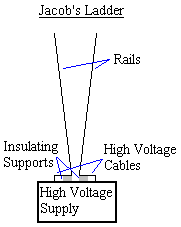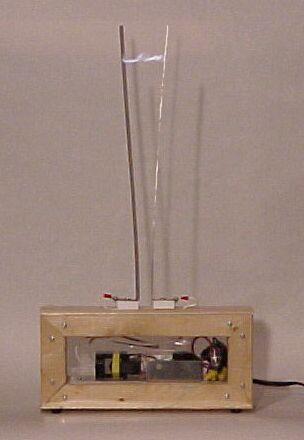
A Jacob's Ladder is very easy to make. All you really need is a high voltage power supply, two metal rods, and some kind of insulating support for the rods. The power supply only needs to be of a sufficient voltage to break down the air at the base of the V (5kV and up will do). It is the current that is important. Voltage will determine how far apart an arc can start, and current will determine how far the arc can be spread apart. Neon sign transformers and oil burner transformers work good. Neon sign transformers and oil burner transformers are normally current limited, so you wont need to worry about this if you use them. A fuse isn't a bad idea either. But I don't recommend using microwave oven transformers. First off, they don't produce any more than 2.5kV, so two or more in series would be needed. The insulation in the transformer is not rated for the voltages that will appear when they are put in series. Also, they are not current limited, so some sort of series resistor will be needed. Even if they are current limited, their secondaries can put out amps of power.
The rails can be just copper wire (16AWG or larger should be used), or even a coat hanger, just sand off the paint. The rails must also be smooth, because any bumps will cause the arc to "stick" to it.
The insulating support(s) for the rails must insulate both the high voltage and heat. They can be made of ceramic, polytetrafluoroethylene (PTFE, or Teflon), or anything else that will insulate the high voltage and won't melt or break from the heat.
You might want to put the rails in an enclosure, because it keeps any breezes from extinguishing the arc, and it holds in the warm air, so you will get longer arcs. The arc is like a very hot flame, and will burn wood, melt and burn plexiglass, and shatter glass, so just remember to give the arc some space. You might also want to give it a little ventilation at the top.
Another thing you can try to do for better performance, is have a small metal tube a few inches under the rails, and put some type of flammable gas through the tube, and ignite it at the end. The flame will heat up the air in between the rails, causing it to conduct better. But the flame itself is very conductive, so keep the flame far enough below the rails, that the Jacob's Ladder won't arc to the flame.
Different experiments can also be done with the Jacob's Ladder. Try putting different salts and metals on the rails to make the arc turn different colors. The sodium in sodium chloride (table salt) and sodium bicarbonate (baking soda) will create a bright yellow arc. Lithium will create a red arc, and magnesium will create a bright white arc. If you know anything about fire works, you can try and get the different salts and metals used in them to make the colors, and they should produce the same colors in the arc as in the fireworks. To put the salts and metals on the rails you can make a mixture of the salt or metal in water and paint it on, or wet the rails with water and powder on the salts and metals.
You can also try playing around with the arc using one of those cheap plastic foot pumps. I've been able to blow the arc from the top of the rails back down to the bottom. And used in reverse, if I use the pump to suck the arc up it will actually bend into and out of the tube, and stay stuck there.

Above is a picture of my Jacob's Ladder. The rails are insulated from the wood with
PTFE, and the high voltage supply is a 12kV transformer that runs at about 40kHz. The
driving circuit runs off 120VAC, and has a built in GFCI. It works pretty good, but a
simple transformer will work just as well.